The
AIDS Epidemic and the Ryan White CARE Act
Past Progress, Future Challenges 2002-2003
| For a printer-friendly version, download the PDF File (13.4 MB). |
U.S.
Department of Health and Human Services
Health Resources and Services Administration
HIV/AIDS Bureau
301.443.1993
http://hab.hrsa.gov


Health Care, Counseling and Testing, Health Insurance Continuation, Home-Based Care, Adherence Support, Medications, Case Management, Risk Reduction, Permanency Planning, Client Client Advocacy, Counseling, Specialty Care, Substance Abuse Treatment, Mental Health Care, Dental Services, Primary Health Care, Emergency Financial Assistance, Food Banks, Health Education, Housing Assistance, Outreach, Referrals, Transportation, Health Care, Counseling and Testing, Health Insurance Continuation, Home-Based Care, Adherence Support, Medications, Case Management, Risk Reduction, Permanency Planning, Client Advocacy, Counseling, Specialty Care, Substance Abuse Treatment, Mental Health Care, Dental Services, Primary Health Care, Emergency Financial Assistance, Food Banks, Health Education, Housing Assistance, Outreach, Referrals, Transportation, Health Care, Counseling and Testing, Health Insurance Continuation, Home-Based Care, Adherence Support, Medications, Case Management, Risk Reduction, Permanency Planning, Client Advocacy, Counseling, Specialty Care, Substance Abuse Treatment, Mental Health Care, Dental Services, Primary Health Care, Emergency Financial Assistance, Food Banks, Health Education, Housing Assistance, Outreach, Referrals, Transportation, Health Care, Counseling and Testing, Health Insurance Continuation, Home-Based Care, Adherence Support, Medications, Case Management, Risk Reduction, Permanency Planning, Client Advocacy, Counseling, Specialty Care, Substance Abuse Treatment, Mental Health Care, Dental Services, Primary Health Care, Emergency Financial Assistance, Food Banks, Health Education, Housing Assistance, Outreach, Referrals, Transportation,
![]()
CARE ACT ADMINISTRATION: THE HIV/AIDS BUREAU
The Ryan White CARE Act is administered by the U.S. Department of Health and Human Services, Health Resources and Services Administration, HIV/AIDS Bureau. The Bureau provides a wide range of management and technical services to CARE Act grantees throughout the country. These services range from technical assistance and training to education and evaluation.
For access to Bureau publications and tools, visit http://hab.hrsa.gov. To order publications, call the HRSA Information Center at 1-888-ASK-HRSA.
This report was prepared by Impact Marketing & Communications and Sandra Macdonald Design under terms of Contract #231-01-0052.
The AIDS Epidemic and the Ryan White CARE Act Past Progress, Future Challenges 2002–2003
U. S
. Department of Health and Human Services
Health Resources and Services Adminstration
HIV/AIDS Bureau

We think of them as HEROES, but they would say that they’re simply doing WHAT NEEDS TO BE DONE, that their work is just beginning, that more people are living with HIV disease in the United States than ever before.
America is filled with people who are fighting for what is RIGHT and DECENT and HUMANE.

America is a place where a suburban mother pushes herself across her first AIDS RIDE, where a lawyer packs a meal in an AIDS KITCHEN, where a student becomes an AIDS BUDDY.
It is a place where a volunteer gives someone a ride, where a case manager helps a man find housing, where a peer outreach worker links an HIV-positive woman to the FIRST HEALTH CARE SHE HAS EVER HAD.
 The
Ryan White CARE Act: A Nation Responds to AIDS
The
Ryan White CARE Act: A Nation Responds to AIDS
San Francisco, Capitola, Mobile, Ossining, Santa Barbara, San Marcos, Los Angeles, Hauppauge, Seattle, Reno, Culver City, Panama City, Burbank, Torrance, Window Rock, Denver, San Antonio, Houston, Dallas, Jefferson City, Des Moines, Sioux City, Stockton, Ukiah, Minneapolis, Brooklyn, Davenport, Paterson, Key West, Iowa City, Biloxi, Indianapolis, Chicago, St. Louis, Birmingham, Jackson, Atlanta, New Orleans, Tampa, Winter Park, Miami, Durham, Washington, DC, Baltimore, Newton Grove, Reno, Loma Linda, Gainesville, Augusta, Lexington, Charlottesville, Allentown, Harlingen, Pine Bluff, Baton Rouge, Asheville, Pittsburgh, Peoria, Roxbury, Wilmington, Waycross, Newark, Bronx, Somerville, Bridgeport, Providence, Hobson City, Brookline, Dorchester, East Boston, Nashville, Burlington, Albany, Memphis, San Juan, Anchorage, San Francisco, Capitola, Mobile, Ossining, Arroyo, Santa Barbara, San Marcos, Los Angeles, Hauppauge, Seattle, Reno, Culver City, Panama City, Burbank, Torrance, Window Rock, Denver, San Antonio, Houston, Dallas, Jefferson City, Des Moines, Sioux City, Stockton, Ukiah, Minneapolis, Brooklyn, Davenport, Paterson, Key West, Iowa City, Biloxi, Indianapolis, Chicago, St. Louis, Birmingham, Jackson, Atlanta, New Orleans, Tampa, Winter Park, Miami, Durham, Washington, DC, Baltimore, Newton Grove, Reno, Loma Linda, Gainesville, Augusta, Iowa City, Lexington, Charlottesville, Allentown, Harlingen, Pine Bluff, Baton Rouge, Asheville, Pittsburgh, Peoria, Roxbury, Wilmington, Waycross, Newark, Bronx, Somerville, Bridgeport, Providence, Hobson City, Brookline, Dorchester, East Boston, Nashville, Burlington, Albany, Memphis, San Juan, Anchorage, Augusta, Iowa City, Lexington, Charlottesville, Allentown, San Francisco, Capitola, Mobile, Ossining, Arroyo, Santa Barbara, San Marcos, Los Angeles, Hauppauge, Seattle, Reno, Culver City, Panama City, Burbank, Torrance, Window Rock, Denver, San Antonio, Houston, Dallas, Jefferson City, Des Moines, Sioux City, Stockton, Ukiah, Minneapolis, Brooklyn, Davenport, Paterson, Key West, Iowa City, Biloxi, Indianapolis, Chicago, St. Louis, Birmingham, Jackson, Atlanta, New Orleans, Tampa, Winter Park, Miami, Durham, Washington, DC, Baltimore, Newton Grove, Reno, Loma Linda, Gainesville, Augusta, Iowa City, Lexington, Charlottesville, Allentown, Harlingen, Pine Bluff, Baton Rouge, Asheville, Pittsburgh, Peoria, Roxbury, Wilmington, Waycross, Newark, Bronx, Somerville, Bridgeport, Providence, Hobson City, Brookline, Dorchester, East Boston, Nashville, Burlington, Albany, Memphis, San Juan, Anchorage, San Francisco, Capitola, Mobile, Ossining, Arroyo, Santa Barbara, San Marcos, Los Angeles, Hauppauge, Seattle, Reno, Culver City, Panama City, Burbank, Torrance, Window Rock, Denver, San Antonio, Houston, Dallas, Jefferson City, Des Moines, Sioux City, Stockton, Ukiah, Minneapolis, Brooklyn, Davenport, Paterson, Key West, Iowa City, Biloxi, Indianapolis, Chicago, St. Louis, Birmingham, Jackson, Atlanta, New Orleans, Tampa, Winter Park, Miami, Durham, Washington, DC, Baltimore, Newton Grove, Reno, Loma Linda, Gainesville, Augusta, Lexington, Charlottesville, Allentown, Harlingen, Pine Bluff, Baton Rouge, Asheville, Pittsburgh, Peoria, Roxbury, Wilmington, Waycross, Newark, Bronx, Somerville, Bridgeport, Providence, Hobson City, Brookline, Dorchester, East Boston, Nashville, Burlington, Albany, Memphis, San Juan, Anchorage, San Francisco, Capitola, Mobile, Ossining, Arroyo, Santa Barbara, San Marcos, Los Angeles, Hauppauge, Seattle, Reno, Culver City, Panama City, Burbank, Torrance, Window Rock, Denver, San Antonio, Houston, Dallas, Jefferson City, Des Moines, Sioux City, Stockton, Ukiah, Minneapolis, Brooklyn, Davenport, Paterson, Key West, Iowa City, Biloxi, Indianapolis, Chicago, St. Louis, Birmingham, Jackson, Atlanta, New Orleans, Tampa, Winter Park, Miami, Durham, Washington, DC, Baltimore, Newton Grove, Reno, Loma Linda, Gainesville, Augusta, Iowa City, Lexington, Charlottesville, Allentown, Harlingen, Pine Bluff, Baton Rouge, Asheville, Pittsburgh, Peoria, Roxbury, Wilmington, Waycross, Newark, Bronx, Somerville, Bridgeport, Providence, Hobson City, Brookline, Dorchester, East Boston, Nashville, Burlington, Albany, Memphis, San Juan, Anchorage,
AIDS
IN THE UNITED STATES
" 40,000 people are infected with HIV every year.1
" One-quarter are age 21 or younger.2
" 15,245 died from AIDS in the year 2000.3
The Ryan White Comprehensive AIDS Resources Emergency (CARE) Act: A Nation Responds to AIDS
In rural Alabama, women and men receive care because the community found a way to rebuild after a match ignited by hate destroyed their HIV clinic almost 10 years ago.
On New York City’s Madison Avenue, blocks and light years away from high-end boutiques and designer showrooms, the North General Hospital AIDS Center serves 700 impoverished men and women who are living with a disease most thought they would never get: Almost all of them are heterosexual.
In Tennessee, Chattanooga C.A.R.E.S. combines CARE Act funds with foundation support and proceeds from the local AIDS Walk to care for a client population whose average income is $538 per month.
These efforts are replicated every day across the country where, with CARE Act support, communities take care of their own.
AIDS is an epidemic of deprivation—people lose their health, their ability to work, their health insurance, and their capacity to provide for themselves. AIDS can also mean loss of support when people need it most. Some are fired from their jobs; others are unable to work. Many are abandoned by their families and friends, deprived of the personal and social relationships that make us human and humane. Ryan White himself was told to leave town.
For people living with HIV/AIDS, the CARE Act meets needs that other safety net programs don’t. Its impact is fewer deaths, slower progression to AIDS, and radical reduction in infants living with HIV disease. The CARE Act provides access to the best clinical treatment anywhere in the world. And it can also mean access to a food bank, or counseling, or help with finding housing—for what is a protease inhibitor to someone without a home?

 CARE
ACT SERVICES
CARE
ACT SERVICES
The CARE Act provides services that people can’t get anywhere else—either because they can’t pay or don’t qualify, or because the services themselves aren’t available.
In 2000
the CARE Act funded more than 4 million health care visits through its
two largest programs alone (Title I grants to Eligible Metropolitan Areas
and Title II
grants to States and Territories).6
Although most CARE Act dollars are spent on medical care and treatment, services that are essential to well-being and survival are also funded—services like housing assistance for a runaway youth, case management for a mother struggling to stay in care, and transportation for HIV-positive patients for whom bus fare is a luxury.
Hundreds of thousands of CARE Act clients receive support services each year, although those costs account for only a small percentage of CARE Act spending, because such services are less expensive to provide than medical care. Support services are essential to the long-term health of people living with HIV disease. Without support services, people served by the CARE Act—people commonly dealing with a constellation of severe socioeconomic and health problems in addition to HIV infection—cannot hope to stay in care over time.
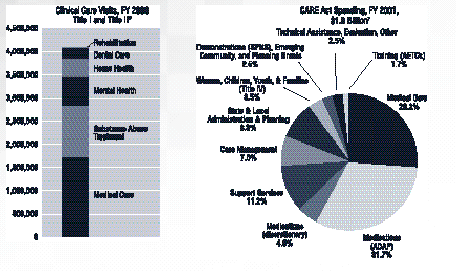
THE PAYER OF LAST RESORT
Consider
a low-wage worker living with HIV disease. Suppose that he or she is fortunate
enough to work for an employer who provides at least some health insurance,
but the coverage only extends to hospitalization expenses. The worker
is not eligible for Medicaid yet cannot afford outpatient medical expenses—office
visits, laboratory tests and, of course, medications, which for highly
active antiretroviral therapy (HAART) alone can cost $15,000 annually.
Ryan White CARE Act services are available to help this patient. The CARE Act is the payer of last resort—that is, when all other options have been exhausted and there is still no other source of payment, the CARE Act may be used to provide services. Even for the sickest, poorest individuals, however, the CARE Act is not an entitlement. The need for services far surpasses the CARE Act’s resources.
CARE ACT CLIENTS
Every year, the Ryan White CARE Act reaches 533,000 individuals in the United States and its Territories.
Some people rely on CARE Act resources for all of their medical and support services. Others depend on the CARE Act for just a few, or perhaps only one, of the services they need.
The CARE Act exists because many people lack the insurance and financial resources to pay for care; they also may not have the social and familial support that is essential for coping with a debilitating and stigmatized disease. Even those with private health insurance may depend on the CARE Act for essential support services. Women and minorities make up significant portions of the CARE Act client base, which is not surprising, because both groups are at a disproportionate risk for poverty and lack of insurance.
In 2000, 25 percent of new AIDS cases were among women.9 That year, 33 percent of all CARE Act clients were women, an increase from 29 percent in 1997. Likewise, the proportion of CARE Act clients who are minority continues to grow, from 66 percent in 1997 to 69 percent in 2000.10
The
demographics of CARE Act consumers are changing in other important ways.
For example, the average age of clients is rising. More and more clients
are in a comparably late stage of disease when they enter care. And providers
are reporting that clients increasingly are poor and have serious health
problems in addition to HIV/AIDS. These developments represent challenges
for providers and communities striving to help. The CARE Act gives them
the tools with which to meet those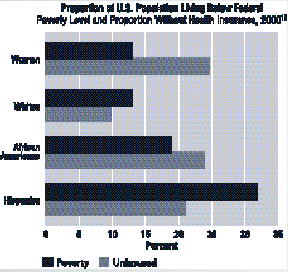 challenges and position themselves to respond to an epidemic that continues
to evolve.
challenges and position themselves to respond to an epidemic that continues
to evolve.
TREATMENT COSTS
In 1996,
before the proliferation of HAART, the average annual cost of HIV care
was $21,504, or $1,792 per month. In 1997, as HAART therapy became more
widely used, the average annual cost of HIV care dropped to $16,308, or
$1,359 per month. But in 1998, the average annual cost rose to $18,300
or $1,525 per month: On average, 55 percent of a patient’s total expenditure
was for medication, 15 percent was for outpatient services, and 30 percent
was for hospitalization.8
AIDS: An Epidemic in Transition
Side Effects, Poverty, Inflation, Rural, Co-morbidity, Women, Latino, Hepatitis C, Underemployed, Treatment Failure, Transgender, Heterosexual, Suburban, African American, Adolescents, Mental Illness, Unskilled, Resistance, Gay, Underserved, Asian, Middle Aged, Addiction, Middle Class, "Straight," Uninsured, Pacific Islander, Southern, Substance Abuse, Poor Housing, Married, Native American, Young People, Tuberculosis, Mutations, White, Stereotypes, Side Effects, Poverty, Inflation, Rural, Bisexual, Comorbidity, Women, Latino, Hepatitis C, Underemployed, Treatment Failure, Transgender, Heterosexual, Suburban, African American, Adolescents, Mental Illness, Unskilled, Resistance, Gay, Underserved, Asian, Middle Aged, Addiction, Middle Class, "Straight," Uninsured, Pacific Islander, Southern, Substance Abuse, Poor Housing, Married, Native American, Young People, Tuberculosis, Mutations, White, Stereotypes, Side Effects, Poverty, Inflation, Rural, Bisexual, Comorbidity, Women, Latino, Hepatitis C, Underemployed, Treatment Failure, Transgender, Heterosexual, Suburban, African American, Adolescents, Mental Illness, Unskilled, Resistance, Gay, Underserved, Asian, Middle Aged, Addiction, Middle Class, "Straight," Uninsured, Pacific Islander, Southern, Substance Abuse, Poor Housing, Married, Native American, Young People, Tuberculosis, Mutations, White, Stereotypes, Side Effects, Poverty, Inflation, Rural, Bisexual, Comorbidity, Women, Latino, Hepatitis C, Underemployed, Treatment Failure, Transgender, Heterosexual, Suburban, African American, Adolescents, Mental Illness, Unskilled, Resistance, Gay, Underserved, Asian, Middle Aged, Addiction, Middle Class, "Straight," Uninsured, Pacific Islander, Southern, Substance Abuse, Poor Housing, Married, Native American, Young People, Tuberculosis, Mutations, White, Stereotypes, Side Effects, Poverty, Inflation, Rural, Bisexual, Comorbidity, Women, Latino, Hepatitis C, Underemployed, Treatment Failure, Transgender, Heterosexual, Suburban, African American, Adolescents, Mental Illness, Unskilled, Resistance, Gay, Underserved, Asian, Middle Aged, Addiction, Middle Class, "Straight," Uninsured, Pacific Islander, Southern, Substance Abuse, Poor Housing, Married, Native American, Young People, Tuberculosis, Mutations, White, Stereotypes, Side Effects, Poverty, Inflation, Rural, Bisexual, Comorbidity, Women, Latino, Hepatitis C, Underemployed, Treatment Failure, Transgender, Heterosexual, Suburban, African American, Adolescents, Mental Illness, Unskilled, Resistance, Gay, Underserved, Asian, Middle Aged, Addiction, Middle Class, "Straight," Uninsured, Pacific Islander, Southern, Substance Abuse, Poor Housing, Married, Native American, Young People, Tuberculosis, Mutations, White, Stereotypes, Side Effects, Poverty, Inflation, Rural, Bisexual, Comorbidity, Women, Latino, Hepatitis C, Underemployed, Treatment Failure, Transgender, Heterosexual, Suburban, African American, Adolescents, Mental Illness, Unskilled, Resistance, Gay, Underserved, Asian, Middle Aged, Addiction, Middle Class, "Straight," Uninsured, Pacific Islander, Southern, Substance Abuse, Poor Housing, Married, Native American, Young People, Tuberculosis, Mutations, White, Stereotypes, Side Effects, Poverty, Inflation, Rural, Bisexual, Comorbidity, Women, Latino, Hepatitis C, Underemployed, Treatment Failure, Transgender, Heterosexual, Suburban, African American, Adolescents, Mental Illness, Unskilled, Resistance, Gay, Underserved, Asian, Middle Aged, Addiction, Middle Class, "Straight,"
AIDS
IN THE UNITED STATES 12
"
Every 13 minutes: Someone is infected with HIV.
" Every 13 minutes: Someone is diagnosed with AIDS.
" Every 34 minutes: Someone dies from AIDS.
AIDS: An Epidemic in Transition
 The
AIDS epidemic has changed dramatically over the past 20 years.
The
AIDS epidemic has changed dramatically over the past 20 years.
-
From 1981 to 1987, 92 percent of reported AIDS cases were among men, compared to 74 percent during the period 1996–2000.13
-
The proportion of new AIDS cases among African Americans almost doubled over the same 20-year period, from 25.5 percent (1981–1987) to 44.9 percent (1996–2000).13
-
Although gay and bisexual men continue to become infected with HIV in catastrophic proportions, fewer than 4 in 10 (39.6 percent) reported AIDS cases were related to the HIV exposure category "men who have sex with men" in 2000.14
The epidemic has changed not just in terms of who has AIDS and how they contracted HIV infection but in how the disease is treated. First there was the introduction of treatments for opportunistic infections, and then the introduction of AZT. By 1995, AZT-based regimens were dramatically reducing the number of infants contracting HIV infection. And then came something called HAART.
HAART,
or highly active antiretroviral therapy, has changed the way we think
about AIDS. For many people it has transformed a fatal disease into a
chronic, manageable condition. Deaths from AIDS have plummeted, and progression
from HIV infection to AIDS has slowed. The result? A mother sends her
children off to school; a migrant farm-worker holds his daughter; a reading
teacher stands before his second grade class; a man living in poverty
continues the struggle for a better life.
But the issue of what has been achieved—and what hasn’t—is not always well understood. Some people believe a cure has been found. Others assume that everyone has access to life-saving medications. Still others believe that AIDS kills only where resources are in short supply.
Nothing could be further from the truth.
THE
MIRACLE OF HAART IS ONLY PART OF THE STORY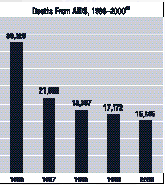
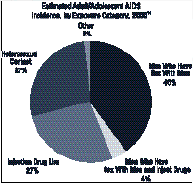
HAART costs more per year than many CARE Act clients earn.
HAART is complex. Patients may be required to take perhaps dozens of pills in a single, 24-hour period, some with food, some without; some in a single dosing, some 4 times daily; some 4 hours before eating, some 30 minutes after. Even a single missed dose can threaten the regimen’s efficacy.
And
the list of HAART’s side effects is neither short nor pleasant. In fact,
the effects of the drugs can feel more devastating than the disease they
were created to stop.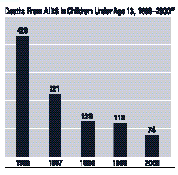
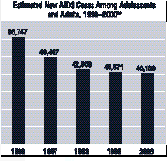
HAART requires intensive medical management and substantial commitments from both the patient and the care team. It may require more frequent monitoring than otherwise would have been necessary. And all of these challenges exist in the context of health care inflation that affects even the best insured patients and best funded providers.
THE CHANGING EPIDEMIC
Beyond HAART lies a domestic AIDS epidemic that might not be widely recognized by the average citizen.
It is an epidemic in which not everyone is living with restored health and is back at work. It is an epidemic in which people contracting HIV disease are often young and dauntingly misinformed about AIDS. It is an epidemic in which, increasingly, those affected are poor. It is an epidemic of treatment success and, tragically, treatment failure. And it is an epidemic in which people cannot afford to pay for drugs, providers are under-funded, and hundreds of thousands of Americans do not benefit from HAART—or any other treatment—because they are not in care.
 A
Poorer HIV-Positive Population
A
Poorer HIV-Positive Population
The AIDS epidemic in the United States is expanding among individuals living in poverty. And although certainly not everyone contracting HIV today is poor, the relationship between the disproportionate burden of poverty borne by minorities and the fact that minorities now constitute the majority of new AIDS cases reported each year cannot be denied.
Five
years ago, results from the HIV Cost and Services Utilization Study, the
Nation’s most com - prehensive study of HIV-positive individuals receiving
care, indicated that compared with the general population, individuals
in care for HIV disease "were about half as likely to be employed,
to have household income above the 25th percentile, or to have private
insurance." The study revealed that
-
63 percent of people in care were unemployed;
-
72 percent had annual household incomes of less than $25,000, and 46 percent had incomes of less than $10,000;
-
only 32 percent had private health insurance; and
-
20 percent had no insurance at all, either public or private.32
 CARE
Act clients are poorer than HIV-positive people who do not rely on the
program, and current data suggest that they have become more so. Consider
the incomes of new clients who entered the CARE Act’s Title III Early
Intervention Program over the past 5 years (see chart, page 13). Of the
25,060 new patients served in 2000, 74 percent had incomes equal to or
below the Federal poverty level for a family of four (which in 2000 was
$17,050), an increase of 10 percentage points since 1996.34
CARE
Act clients are poorer than HIV-positive people who do not rely on the
program, and current data suggest that they have become more so. Consider
the incomes of new clients who entered the CARE Act’s Title III Early
Intervention Program over the past 5 years (see chart, page 13). Of the
25,060 new patients served in 2000, 74 percent had incomes equal to or
below the Federal poverty level for a family of four (which in 2000 was
$17,050), an increase of 10 percentage points since 1996.34
The intersection of the AIDS epidemic and poverty is clearly illustrated in the need for housing. The problem is revealed in studies both of people living with HIV disease and of the homeless. A 1997 Los Angeles study of 785 people living with HIV disease found that 65 percent had been homeless and 53 percent had had to move in the past year.35 In Philadelphia, people admitted to public shelters had HIV disease at rates 9 times higher than the city’s general population.36 In 2001, the National Low Income Housing Coalition (using the Federal guideline that housing should cost no more than 30 percent of individual income) reported that on average in the United States, "a worker earning minimum wage would have to work 108 hours per week to afford the median fair market rent for a two-bedroom rental unit, or a household must have the equivalent of two and a half minimum wage workers."37
A More Isolated HIV-Positive Population
Fueled by rapid expansion of the epidemic in Texas and Florida, the South is now the region with the most reported AIDS cases in the United States each year.38 While in real terms most infections still occur in urban regions, the proportion occurring in rural areas has increased.39
Whether
people with HIV live in a small town in rural Vermont or a sprawling southern
city, they are increasingly isolated from health care and from
the support they need to access care, stay in care, and thrive. The isolation
persists for several reasons.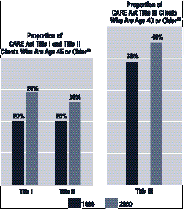
Although AIDS is not confined to any particular part of a city, a substantial portion of regional services and expertise is sometimes located in neighborhoods where the epidemic has been in the past, but not necessarily where it is going. People in rural areas and minority neighborhoods may have limited access to health care providers—whether they have health insurance or not. They are also less likely to have access to providers with experience in treating HIV infection and providing the support services that are absolutely essential for long-term survival. Even in areas where services are available, HIV-positive individuals living in small communities may be reluctant to pursue them, not wanting to be seen sitting in the "AIDS doctor’s" waiting room or standing in line at the pharmacy.
Where distance is not a factor in accessing care, cultural factors, stigma, and fear often are. Consider the plight of an individual who would never consider seeking care at an organization perceived to be "gay oriented," either because of his or her own feelings or because of the perceived feelings of friends, families, and neighbors. Consider the plight of the person who has lost his job—or fears losing it—because he is gay. Consider the plight of a mother who is determined that her children not discover strange medicines on the bathroom shelf, or of the young person who still lives at home—infected, afraid, and with nowhere to turn.
 An
Aging HIV-Positive Population
An
Aging HIV-Positive Population
Changes in the age of CARE Act clients reflect the benefits of HAART and an aging HIV-positive CARE Act client base: 26 percent of the people served through Title II grants to States and Territories were age 45 or older in 2000, up from 20 percent in 1998. The growth in the number of such clients among Title I Eligible Metropolitan Area clients was even greater—from 20 percent in 1998 to 29 percent in 2000.43
HIV-positive people in higher age brackets experience the same health problems as their HIV-negative peers do—higher rates of hypertension, high cholesterol, diabetes, and heart disease—but the treatment of more than one chronic illness at a time poses several challenges. How chronic illnesses affect the course and treatment of HIV infection is not entirely understood. One issue is the interaction of treatments for diverse chronic health problems. Another consideration is how the side effects and symptoms of one illness affect a person’s ability to tolerate treatment for another condition. The development of age-related conditions affects not only patients but also CARE Act providers. Often, they are the only source of health care for their clients, but they generally specialize in infectious disease, not rheumatology or cardiology. Providers are increasingly in the position of having to develop new skills.
Thus the benefits of HAART—as reflected in an older HIV-positive population—are placing new demands on the CARE Act system.
An
HIV-Positive Population Increasingly
Suffering From Multiple Diagnoses It is not surprising that as people live longer and the epidemic continues its shift toward those who have historically lacked access to health care, many people living with HIV, regardless of age, have multiple health problems. For example, 25 percent of the HIV-positive population is estimated to be co-infected with hepatitis C.45
Of all conditions commonly found among the HIV-positive population, perhaps substance abuse and mental illness loom largest. In 2001, the Archives of General Psychiatry published this startling estimate:
Of the 231,400 HIV-positive individuals estimated to be in care during a 6-month period in 1996, 61.4 percent used mental health or substance abuse services.46 In fact, one need look no further than surveillance data to begin to see the scope of the substance abuse problem: Of the 338,978 people living with AIDS in 2000, 27.4 percent are believed to have contracted HIV through injection drug use, and of the 15,245 who died in 2000, 34 percent contracted the virus through this transmission mechansim.47
These data say nothing of those who used non-injected substances, such as alcohol, cocaine, ecstasy, gamma-hydroxybutyrate (known as GHB, a "club drug"), and other drugs that impair decision making.
 A
Growing Need for Services
A
Growing Need for Services
Deaths from AIDS dropped to 15,245 in 2000,51 but 40,000 new HIV infections are estimated to have occurred.1 Therefore, approximately 24,000 more people were living with HIV disease at the end of 2000 than at the beginning, and all of them need to be receiving care. Other factors are also at work.
The level of need among people living with HIV disease is growing while the Nation experiences an ongoing health care crisis: 30 million adults and 9 million children are uninsured, millions more are underinsured, and health care costs continue to soar.53
All these factors combined—the growing number of people living with HIV disease, a poorer population that is living longer but with higher rates of a whole range of health problems, and crises in both insurance and health care costs—are bringing ever increasing demands on CARE Act services.
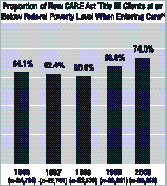 SIDE
EFFECTS OF HAART33
SIDE
EFFECTS OF HAART33
(Partial List)
-
Anorexia (loss of appetite or aversion to food)
-
Asthenia (weakness or debility)
-
Cough
-
Diarrhea
-
Fever
-
Headache
-
Insomnia
-
Lipodystrophy
-
Malaise
-
Nausea, vomiting
-
Pancreatitis
-
Peripheral neuropathy (numbness in extremities)
-
Stomatitis (inflammation of the mouth)
-
Rash
HIV/AIDS AND POVERTY48
-
Lost productivity
-
Catastrophic costs of health care
-
Increased dependency
-
Children with worse nutrition, lower school enrollment
-
Decreased capacity to manage households
-
Reduced community income
THE AIDS EPIDEMIC AND PEOPLE OF COLOR
Today, 69 percent of all CARE Act clients are minorities, reflecting both the disproportionate level of need that this community bears and the Health Resources and Services Administration’s (HRSA) commitment to reach out to individuals whose barriers to health care have often been insurmountable (see chart, page 26).
The national tragedy of AIDS cannot be separated from another tragedy: the stigma, disenfranchisement, poor access to health care, and lack of economic opportunity borne by minorities in the United States. The results are all too telling; in the year ending June 30, 2001:
-
three of every five new AIDS cases in men were among minorities (63.8 percent);40
-
four of every five new AIDS cases in women were among minorities (81.9 percent);41
-
four of every five new AIDS cases in children were among minorities (85.6 percent).19
Despite persistent study and analysis of the problem and implementation of initiatives to address it, disparities remain, and minorities—especially African Americans—are suffering a terrible toll. According to a recent Institute of Medicine report, African Americans with HIV infection are less likely than their nonminority counterparts to receive antiretroviral therapy, to receive prophylaxis for pneumocystis pneumonia, and to receive protease inhibitors. These disparities remain, even after adjusting for age, gender, education, and insurance coverage.42
| THE CHANGING EPIDEMIC | 1996 | 2000 |
| Proportion of people living with AIDS who were women49 | 18.6% | 20.6% |
| Proportion who were members of a minority group50 | 58.9% | 62.2% |
| Proportion of all deaths from AIDS that were among minorities51 | 61.4% | 70.3% |
| Proportion of all deaths from AIDS that were among females52 | 18.3% | 24.0% |
FACTORS INCREASING DEMAND FOR OUTPATIENT SERVICES
-
People are living longer and thus require care and services for longer periods of time.
-
People now entering care have high levels of economic and social needs.
-
The number of people living with HIV disease is growing.
-
The aging of the AIDS population is leading to an increased need for services associated with the aging process.
-
People with HIV disease increasingly have other health problems—hepatitis, mental illness, and substance abuse, among others.
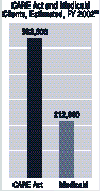
THE CARE ACT AND MEDICAID
Federal and State Medicaid expenditures for people living with HIV disease are estimated to be $7.7 billion in FY 2002, almost 4 times that of the CARE Act ($1.9 billion in FY 2002).
Yet the CARE Act reaches more than twice as many people—an estimated 533,000 people, compared with 212,000 for Medicaid—keeping them out of expensive hospital beds and emergency rooms by providing comprehensive outpatient care and the support services essential for helping people stay healthy over time.
CARE Act Programs: Addressing Local Needs
Health Care, Home-Based Care, Adherence Support, Medications, Case Management, Risk Reduction, Permanency Planning, Client Advocacy, Counseling, Specialty Care, Substance Abuse Treatment, Mental Health Care, Dental Services, Primary Health Care, Emergency Financial Assistance, Food Banks, Health Education, Housing Assistance, Outreach, Referrals, Transportation, Health Care, Counseling and Testing, Health Insurance Continuation, Home-Based Care, Adherence Support, Medications, Case Management, Risk Reduction, Permanency Planning, Client Advocacy, Counseling, Specialty Care, Substance Abuse Treatment, Mental Health Care, Dental Services, Food Banks, Health Education, Housing Assistance, Outreach, Referrals, Transportation, Health Care, Counseling and Testing, Health Insurance Continuation, Home-Based Care, Adherence Support, Medications, Case Management, Risk Reduction, Permanency Planning, Client Advocacy, Counseling, Specialty Care, Substance Abuse Treatment, Mental Health Care, Dental Services, Primary Health Care, Emergency Financial Assistance, Food Banks, Health Education, Housing Assistance, Outreach, Referrals, Transportation, Health Care, Counseling and Testing, Health Insurance Continuation, Home-Based Care, Adherence Support, Medications, Case Management, Risk Reduction, Permanency Planning, Client Advocacy, Counseling, Specialty Care, Substance Abuse Treatment, Mental Health Care, Dental Services, Primary Health Care, Emergency Financial Assistance, Food Banks, Health Education, Housing Assistance, Outreach, Referrals, Transportation, Health Care, Counseling and Testing, Health Insurance Continuation, Home-Based Care, Adherence Support, Medications, Case Management, Risk Reduction, Permanency Planning, Client Advocacy, Counseling, Specialty Care, Substance Abuse Treatment, Mental Health Care, Dental Services, Primary Health Care, Emergency Financial Assistance, Food Banks, Health Education, Housing Assistance, Outreach, Referrals, Transportation, Health Care, Counseling and Testing, Health Insurance Continuation, Home-Based Care, Adherence Support, Medications, Case Management, Risk Reduction, Permanency Planning, Client Advocacy, Counseling, Specialty Care, Substance Abuse Treatment, Mental Health Care, Dental Services, Primary Health Care, Emergency Financial Assistance, Food Banks, Health Education, Housing Assistance, Outreach, Referrals, Transportation, Health Care, Counseling and Testing, Health Insurance Continuation, Home-Based Care, Adherence Support, Medications, Case Management, Risk Reduction, Permanency Planning, Client Advocacy, Counseling, Specialty Care, Substance Abuse Treatment, Mental Health Care, Dental Services, Primary Health Care, Emergency Financial Assistance, Food Banks, Health Education, Housing Assistance, Outreach, Referrals, Transportation, Health Care, Counseling and Testing, Health Insurance Continuation, Home-Based Care, Adherence Support, Medications, Case Management, Risk Reduction, Permanency Planning, Client Advocacy, Counseling, Specialty Care, Substance Abuse Treatment, Mental Health Care, Dental Services, Primary Health Care, Emergency Financial Assistance, Food Banks, Health Education, Housing Assistance, Outreach, Referrals, Client Transportation, Health Care, Counseling and Testing, Health Insurance Continuation, Home-Based Care, Adherence Support, Medications, Case Management, Risk Reduction, Permanency Planning, Client Advocacy, Counseling, Specialty Care, Substance Abuse Treatment, Mental Health Care, Dental Services, Primary Health Care, Emergency Financial Assistance, Food Banks, Health Education, Housing Assistance, Outreach, Referrals, Transportation,
AIDS IN THE UNITED STATES
Every 1.8 days a child is diagnosed with AIDS.
The child is 4.5 times more likely to be black than white.19
 CARE
Act Programs: Addressing Local Needs
CARE
Act Programs: Addressing Local Needs
The United States is one of the largest countries on Earth, and one of the most diverse. We come from every corner of the globe. We live in cities and on farms, we are full participants in our community and disenfranchised, we are affluent and living on the brink. Some of us are hungry. Some of us are homeless. Some of us are living with HIV.
We live in communities with outstanding health care systems and in communities without a single practitioner. We live in towns where buses pass near the health clinic and in places where just getting to the doctor costs 3 hours in wages.
We are communities of African Americans who have never had access to health care. We are Latinos and Asians fighting to become part of the melting pot, and we are Native Americans fighting to protect our heritage. We are women attempting to raise our children. We are men struggling to find community. We are substance abusers and athletes, we are young and old.
Many of us living with HIV disease never thought we would be infected. Our communities are as diverse as we are, with different assets, different challenges, and different needs. This diversity demands flexibility, and the CARE Act provides it. CARE Act grants help hard-hit urban regions respond to needs of staggering magnitude. CARE Act grants help States and Territories reach communities that other programs don’t. CARE Act grants help teach clinicians how to provide AIDS care, and they help clinics gear up to serve overburdened neighborhoods that no providers have served before. CARE Act grants support adherence and provide medications, address the barriers faced by minorities and hard-to-reach populations, and help meet the specific needs of perhaps the most vulnerable among us—women, children, youth, and families.
Solutions to the interwoven set of needs facing people living with HIV disease require a comprehensive set of partners—clinics and medical centers, Community and Migrant Health Centers, community-based organizations, AIDS service organizations, health departments, and social services providers—all united in the fight to deliver health care and life-sustaining support.
And the CARE Act succeeds because it puts funds in States and communities across the country, where they can do the most good.
RYAN WHITE CARE ACT APPROPRIATION, FY 2002: $1.9 BILLION
| Program | $ million |
|---|---|
| Title I Grants to Eligible Metropolitan Areas | 619.6 |
| Title II Grants to States and Territories | 338.5 |
| AIDS Drug Assistance Program Grants | 639.0 |
| Title III Grants for Early Intervention Services | 193.9 |
| Title IV Grants to Serve Women, Children, Youth, and Families | 70.9 |
| Part F AIDS Education and Training Centers | 35.3 |
| Dental Reimbursement Program | 13.5 |
| Special Projects of National Significance* | 25.0 |
| *Not a line-item appropriation. | |
 TITLE
I: GRANTS TO ELIGIBLE METROPOLITAN AREAS
TITLE
I: GRANTS TO ELIGIBLE METROPOLITAN AREAS
Metropolitan regions with more than 500,000 inhabitants and at least 2,000 reported AIDS cases during the past 5 years are eligible for Title I grants. The number of Eligible Metropolitan Areas (EMAs) has grown to 51, up from just 16 in 1991. The Title I program reflects that growth. Even though HIV/AIDS is increasingly a problem in small cities and rural areas, the preponderance of AIDS cases continues to be reported in large urban regions. For example, of new AIDS cases reported in the 1-year period from July 2000 to June 2001, 80 percent were in metropolitan areas with populations of at least 500,000 individuals; an additional 11.3 percent were in regions with populations of between 50,000 and 499,999.55 The Title I program is the CARE Act’s largest, and it offers a unique approach to addressing a health care and social crisis. Each Title I grantee uses funds to contract for services to meet local needs and local gaps in systems delivering health care and support services.
Moreover, local government officials alone do not decide which services are needed; instead, this task is conducted by a Planning Council, led by people living with HIV disease and experts from fields like mental health, substance abuse, HIV specialty care, public health, and psychology. Using a comprehensive needs assessment and other health planning tools, the Planning Council makes decisions on where to allocate funds to solve local problems.
TITLE II: GRANTS TO STATES AND TERRITORIES
Care Grants
States and U.S. Territories are eligible to receive CARE Act grants under the provisions of Title II. Grantees allocate about one-third of Title II resources to fund a variety of health care and support services. The largest portion of Title II funds is "earmarked" for the AIDS Drug Assistance Program (ADAP).
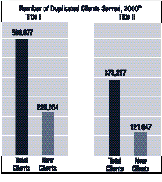 AIDS Drug Assistance Program
AIDS Drug Assistance Program
ADAP funds are used, along with funds contributed by the States and Territories themselves and by other programs, to establish drug assistance programs. Each grantee has wide discretion in establishing eligibility criteria for people living with HIV disease and in deciding which drugs to include in their formularies.
With the CARE Act Amendments of 2000, a small portion of the total ADAP appropriation (3 percent) is set aside for grantees demonstrating "severe need" for additional resources.
Eligibility is determined by State (or Territory) client eligibility standards, its formulary, and the number of people with an income under 200 percent of the Federal poverty guideline.
Grants to Emerging Communities
Provisions in the CARE Act Amendments of 2000 established "emerging community grants" through the Title II program. This new program reflects the fact that regions that do not qualify for EMA status (see Title I above) may nonetheless face heavy burdens related to the AIDS epidemic. Metropolitan areas with more than 500 but fewer than 2,000 reported AIDS cases in the past 5 years are eligible for these grant funds.
TITLE III: EARLY INTERVENTION SERVICES
Early Intervention Services Grants
Title III grants are awarded directly to health care providers, rather than to cities (as in Title I) or States and Territories (as in Title II). Title III funds are generally awarded to university and hospital medical centers, federally-funded Community and Migrant Health Centers, and other clinics.
Many of the Title III Early Intervention Services grants awarded for 2002 are assisting providers in small towns and rural areas.
Planning Grants
and Capacity-Building Grants The changing epidemic is resulting in increased HIV prevalence in areas that have a shortage of HIV/AIDS care providers. Title III planning grants provide funds that organizations may use to prepare for providing HIV-related services in the future. Capacity-building grants expand the capacity of organizations to serve populations in their community.
 TITLE
IV: GRANTS TO SERVE WOMEN, CHILDREN, YOUTH, AND FAMILIES
TITLE
IV: GRANTS TO SERVE WOMEN, CHILDREN, YOUTH, AND FAMILIES
Several factors, both scientific and social, distinguish HIV disease in women, children, youth, and families from that found in the adult male population. Grantees emphasize the crucial role of coordinating care for families. Households living in poverty, who have historically lacked access to health care, face a heavy burden. That burden is redoubled when a family member is HIV positive, and it is heavier still when more than one person in the family unit is living with the disease. Through coordinating what would otherwise be a disjointed array of providers and services, the Title IV grantees improve access to care and to the promise of restored health.
The Title IV program addresses the unique needs of these populations by providing access to a range of comprehensive and coordinated services. These services include neonatal and pediatric specialty care, gynecologic and obstetric care, services for caregivers of HIV-positive children, access to research and clinical trials, and support services ranging from transportation and emergency housing assistance to intensive case management and peer support.
 PART
F
PART
F
Special Projects of National Significance
Through the Special Projects of National Significance (SPNS) program, innovative service delivery methods are implemented and evaluated in the search for more effective means of delivering HIV-related services. When improvements in current service delivery practices are discovered, findings are distributed to the service community at large and replicated throughout the country. Currently, 106 SPNS grants are being used to address a variety of problems facing the Nation. How can we reduce the gap between the number of youth living with HIV disease and those who are currently in care? How do we improve treatment adherence among the various populations affected by the AIDS epidemic? What is the best way to keep people with multiple diagnoses in care over time?
 AIDS
Education and Training Centers
AIDS
Education and Training Centers
A national network of regional AIDS Education and Training Centers (AETCs) provides clinical training for HIV/AIDS care providers. The regional aspect of the program reflects the reality that clinical training needs vary from region to region. Four national programs address specific problems in HIV/AIDS care delivery and enhance the work of the regional centers:
-
The National Minority AETC is improving access to care in minority communities by providing training opportunities for local providers.
-
The National Resource AETC offers materials related to training and care provision.
-
The National Evaluation AETC provides support for measuring the effectiveness of training courses and teaching mechanisms.
-
The National Clinicians’ Consultation offers up-to-the-minute information and individualized, expert case consultation.
The AETC approach to education is innovative. For example, technology is used to bring services to providers who want to become better trained but who cannot easily travel to a distant university or seminar. Moreover, grantees are given leeway with which to design training programs that respond to the particular needs in the regions they serve.
HIV/AIDS Dental Reimbursement Program
Oral health problems are often the first manifestation of HIV infection, and a lack of oral health
AIDS SURVEILLANCE: WHERE WE ARE NOW
Although treatments for HIV disease are more effective than ever, 40,894 new AIDS cases were reported in the United States from July 2000 to June 2001. Nearly 7 of every 10 cases were among minorities 15, 16
At the end of 2000, the Centers for Disease Control and Prevention estimated that 338,978 people in the United States were living with AIDS. A total of 793,026 AIDS cases have been reported in the United States since the onset of the epidemic. 17, 18
CHILDREN
In the United States, 3,787 children under age 13 were believed to be living with AIDS in 2000, and an unknown number were living with HIV infection; 17 194 new AIDS cases were reported in children between July 2000 and June 2001.19 And despite what is known about preventing perinatal transmission, 206 new HIV infections were reported in children over the same period; this number excludes new infections in several large States without confidential HIV reporting systems.20
Since the start of the epidemic, 8,994 AIDS cases have been reported in children in the United States, and more than four of every five (82.6 percent) have been among minorities. Approximately 25 percent of those cases were reported in the State of New York, and 16 percent were reported in Florida.15
ADULTS AND ADOLESCENTS
Most new AIDS cases are among men, but an increasing proportion—about 25 percent in the most recent year—are among women. Of these women, four of every five are minorities.21
Among both men and women, declines in new AIDS cases and in deaths from AIDS have been substantial over the past 8 years. A primary challenge for the CARE Act community has been that those declines have never been equally distributed across populations: Minorities and women have tended to fare worse than white men. Although substantial improvements have been accomplished, differences still exist.
"Estimated new AIDS cases fell by less than 1 percent among African Americans from 1999 to 2000, and estimated deaths from AIDS fell 9.3 percent, compared with 11.2 percent among whites. The disparities were similar among Hispanics.22
"Estimated deaths from AIDS decreased 62.4 percent for men from 1996 to 2000, but just 47.5 percent for women.23 Over the same period, the number of new AIDS cases fell almost twice as much among men as among women (37.4 percent and 21.8 percent, respectively).24
TREATMENT FAILURE AND ADHERENCE
Adherence to treatment regimens for all diseases generally ranges between 20 and 80 percent. People exactly follow their doctor’s orders only about 50 percent of the time.2 8 Patients commonly cite forgetfulness and misunderstanding instructions as reasons for not taking their medication as prescribed.29
HAART demands much higher adherence rates. The treatment’s success can begin to diminish when patients are less than 95 percent compliant—and this for drugs that come with many unpleasant side effects and must be taken according to a complicated schedule.
Studies have shown that adherence to HAART regimens averages about 70 percent—much better than average adherence rates, but still below the threshold needed to have the best chance for beneficial results.30
Adherence, however, does not guarantee treatment success. No drug regimen has completely eradicated HIV from the body, but what is possible is called viral suppression : keeping the amount of virus in the body low. One study found that patients with good adherence to their medication regimens were 15 times more likely to achieve viral suppression than those with poor adherence. 31 Rates are likely to vary by treatment regimen and other factors, but more studies are needed in this area.
When it comes to HIV disease, non-adherence is particularly concerning because it may result both in higher viral loads and in viral resistance, which is the development of virus that will not respond to particular medications. Non-adherence, therefore, not only can lead to uncontrollable disease progression for the patient but also has public health consequences because it may lead to the creation of resistant strains of HIV.
 Solutions
to Adherence Problems: Baltimore
Solutions
to Adherence Problems: Baltimore
The Chase-Brexton Health Clinic in Baltimore provides comprehensive medical care to some of the city’s poorest HIV-positive residents. The problems associated with poverty make adhering to HAART particularly challenging.
The clinic is supported through several CARE Act programs and has recently received a grant to support adherence from HRSA’s
Adherence Initiative. Ilse Levin is the project coordinator. "The clinic has always supported adherence," says Ms. Levin, "and with these new funds, we have the opportunity to provide additional help to clients who need it."
With CARE Act dollars, the clinic has added an adherence nurse to its array of adherence supports. The nurse regularly meets with clients who register for the program to address problems related to HAART. And the nurse collaborates with others in the clinic—case managers, the patient’s care team, and the onsite pharmacist—to measure success. Almost all program participants fill their prescriptions onsite. "The pharmacy can tell us if prescriptions have been filled according to schedule, and we can intervene with the patient accordingly," explains Ms. Levin.
Adherence Initiative funds will allow the clinic to measure how the adherence nurse improves both adherence and patient well-being. And the results will be applicable to providers across the country, because the 175 participants in the program reflect the populations most in need: More than 80 percent are African American, and one in four is female.
 Building
a Future for Families with AIDS: San Diego
Building
a Future for Families with AIDS: San Diego
Perhaps nowhere are the challenges of survival more complex than in families where a child or parent—or a child and a parent—is living with HIV disease. Families affected by the AIDS epidemic are often poor. They fight for the kind of "normal" life that all families want. They struggle to find safe housing and good schools, to find employment and childcare, to find health care for the entire family. AIDS is, for them, another in a long list of serious challenges.
Programs like the San Diego CARE Partnership are helping families transcend the problems of AIDS. A program of the University of California San Diego Mother & Adolescent HIV Program, the Partnership is building a united front of health care providers and social service agencies, so that women, youth, children, and families obtain the benefits of all that today’s science and health care has to offer.
With funding from the CARE Act’s Title IV program, a countywide network of hospitals, Community Health Centers, social service agencies, and consumers is being expanded to deliver family-focused care that leaves no one behind. Eighty percent of people served through the program this year will be people of color. Twenty-five percent will be children. Half will be women, more than one in seven of whom will be pregnant.
By improving access to primary care, mental health, substance abuse, and dental services, the San Diego Title IV program is helping vulnerable families live longer and much healthier lives.
 Fighting
to Serve in Rural Areas: Alabama
Fighting
to Serve in Rural Areas: Alabama
The problem of housing for poor people living with HIV disease is mirrored in the need for housing for the clinics who take care of them. "We have all of this care to provide, but we’re running out of space," explains Dr. Barbara Hanna of the Health Services Center (formerly AIDS Service Center) in rural Alabama. "We worked with Habitat for Humanity to build a house for some of our homeless," says Dr. Hanna, "because people have got to have a place to live. Now we’re dealing with the question of where we are going to house services."
The Service Center currently receives funds through the Title III and SPNS programs. The Center has survived arson and, with few exceptions, a lack of community support. It is a region where it still isn’t safe to say "Health Services Center (formerly AIDS Service Center)" when answering the phone at the clinic.
Dr. Hanna says, "We’re seeing people enter care late in stage of disease, more hepatitis C, and more mental illness—so much mental illness that we have added a psychiatrist to our team. And like other providers, we’re treating problems associated with the aging process, like hypertension—good problems, really, in the sense that we thought [they] would never be an issue—but the treatment costs money.
We need the funds we can raise locally to provide help that grants don’t cover. At the same time, we need to expand, which grants don’t pay for. Do we rent? Do we curtail services? Do we separate our services and provide care at different locations?" she asks. "It is a real dilemma."
 Responding
to Changing Demographics: Detroit
Responding
to Changing Demographics: Detroit
Case Corridor, Lower East Side, and Palmer Park: three areas in Detroit where HIV-infected people not in care are likely to reside, and three areas targeted by the Detroit Eligible Metropolitan Area (EMA) to receive HIV prevention and care services.
HIV prevention and CARE Act providers in Detroit have always collaborated to bring the "hard-to-reach" into care. The EMA now takes medical care to transient individuals via a mobile vehicle. The vehicle is then parked near sites frequented by the target population. From there, they offer a baseline primary care intervention, linkages to specialty care sites, and referrals to other services.
But parts of Detroit have been revitalized. Rents have gone up as neighborhoods have gentrified, and people engaging in high-risk behaviors have been dispersed across the city.
"Storefronts wouldn’t work with us," explains Lydia Meyers, program development coordinator. "Condos went up in Case Corridor, and they now call the neighborhood Midtown. Clients and service agencies were forced to move, and police told us to move our outreach sites."
To keep reaching the same population, the EMA capitalized on its strong relationships with substance abuse treatment providers, a 24-hour walk-in center, soup kitchens, and outreach workers to locate people in their new neighborhoods. By responding to the changing demographics of Detroit, the EMA continues to reach people for whom a mobile access point represents the best hope for getting into care.
 Solutions
That Reflect the Problem: Philadelphia
Solutions
That Reflect the Problem: Philadelphia
HIV-infected individuals often live outside America’s mainstream; have incomes and educational levels far below the median; and histories of abuse, addiction, and mental illness. Many have never had any medical care and avoid interacting with medical providers.
They may fear disclosure. They may not trust the medical establishment. They may live with a sense that an early death is a foregone conclusion.
Grantees like the Philadelphia Eligible Metropolitan Area (Title I) are implementing programs that are bringing HIV-positive individuals into care for the first time.
"Through our Storefront Initiative," says Patricia Bass, Chair of the Communities Advocating Emergency AIDS Relief (CAEAR) Coalition, "we are able to reach people who are not going to walk into a clinic."
The Storefront is a street-level, open-access service site geared to no-appointment-necessary, walk-in traffic and designed to link the hardest of the "hard-to-reach" to care. This population includes people who are disenfranchised to the extent that they are not going to access medical care through traditional means. "Our model is to provide a safe space in affected communities," Ms. Bass says, "where people can access services in an environment that they feel is non-threatening."
The result: 275 people were brought into care last year.
 Notes
Notes
-
Centers for Disease Control and Prevention (CDC). A glance at the HIV epidemic [Fact sheet]. Available at: http://www.cdc.gov/nchstp/od/news/At-a-Glance.pdf.
-
Office of National AIDS Policy. The National AIDS Strategy, 1997. Available at: http://clinton2.nara.gov/ONAP/nas/ns_toc.html.
-
CDC. HIV/AIDS Surveillance Report.2001;13(1):35. Table 30.
-
HRSA, Ryan White CARE Act 2000 Title IV Data Report, 2001, p. 28. Available at: http://hab.hrsa.gov/reports/tiv2000v.htm.
-
HRSA, Ryan White CARE Act 2000 Annual Administrative Report, 2001, p. 5, 30. Available at: ftp://ftp.hrsa.gov/hab/saarfinal2000.pdf.
-
HRSA, Ryan White CARE Act 2000 Annual Administrative Report, 2001, p. 12, 27 Available at: ftp://ftp.hrsa.gov/hab/saarfinal2000.pdf.
-
HRSA, HIV/AIDS Bureau, unpublished data.
-
Bozzette SA, et al. Expenditures for the care of HIV-infected patients in the era of highly active antiretroviral therapy. N Engl J Med. 2001;344:817.
-
CDC. HIV/AIDS Surveillance Report.2000;12(2):14. Table 5.
-
HRSA, HIV/AIDS Bureau, Office of Science and Epidemiology, unpublished data.
-
Dalaker J. Poverty in the United States: 2000. Washington, DC: U.S. Bureau of the Census; 2001:7, Table B. Current Population Reports Series P60-214; Henry J. Kaiser Family Foundation. Health Insurance Coverage in America: 2000 Data Update. Washington, DC: Kaiser Commission on Medicaid and the Uninsured; 2002. Available at: http://www.kff.org/content/2002/4007/.
-
Calculations based on CDC estimates of new HIV infections, AIDS incidence, and AIDS deaths per year divided by 525,600 minutes per year. Sources: CDC. A glance at the HIV epidemic [Fact sheet]. Available at: http://www.cdc.gov/nchstp/od/news/At-a-Glance.pdf; CDC. HIV/AIDS Surveillance Report. 2001;13(1):12, 35. Tables 5, 30.
-
CDC. HIV and AIDS—United States, 1981–2000. MMWR. 2001;50(21):431.
-
CDC. HIV/AIDS Surveillance Report. 2001;13(1):27-8. Tables 19, 20.
-
CDC. HIV/AIDS Surveillance Report. 2001;13(1):6.Table 2.
-
CDC. HIV/AIDS Surveillance Report. 2001;13(1):16, 18. Tables 9, 11.
-
CDC. HIV/AIDS Surveillance Report. 2001;13(1):33. Table 27.
-
CDC. HIV/AIDS Surveillance Report. 2001;13(1):6. Table 2.
-
CDC. HIV/AIDS Surveillance Report. 2001;13(1):22. Table 15.
-
CDC. HIV/AIDS Surveillance Report. 2001;13(1):23. Table 16.
-
CDC. HIV/AIDS Surveillance Report. 2001;13(1):12, 18. Tables 5, 11.
-
CDC. HIV/AIDS Surveillance Report. 2001;13(1):30, 34. Tables 23, 29.
-
CDC. HIV/AIDS Surveillance Report. 2001;13(1):35. Table 30.
-
CDC. HIV/AIDS Surveillance Report. 2001;13(1):31. Table 24.
-
CDC. HIV/AIDS Surveillance Report. 2001;13(1):35. Table 30.
-
CDC. HIV/AIDS Surveillance Report. 2001;13(1):31. Table 24.
-
CDC. HIV/AIDS Surveillance Report.2001;13(1):35. Table 30.
-
Jaret P. 10 ways to improve patient compliance. Hippocrates. 2001;15(2). Available at: http://www.hippocrates.com/FebruaryMarch2001/02features/02feat_compliance.html .
-
Beers MH, Berkow R, eds. The Merck Manual of Diagnosis and Therapy. Whitehouse Station, NJ: Merck & Co.; 2002. Section 22, chapter 301. Available at: http://www.merck.com/pubs/mmanual/section22/chapter301/301d.htm.
-
Stone VE. Strategies for optimizing adherence to highly active antiretroviral therapy: lessons from research and clinical practice. Clin Infect Dis. 2001;33:865-872.
-
Deeks SK. Incidence and predictors of virologic failure in indinavir or ritonavir in an urban health clinic. Program and Abstracts of the 37th Interscience Conference on Antimicrobial Agents and Chemotherapy. Washington, DC: American Society for Microbiology, cited in Max B, Sherer R. Management of the adverse effects of antiretroviral therapy and medication adherence. Clin Infect Dis. 2000;30 Suppl 2:S96-116. Review.
-
Bozzette SA, Berry SH, Duan N, et al. The care of HIV-infected adults in the United States. N Engl J Med. 1998;339:1897-904.
-
Bartlett JG, Gallant JE. Medical Management of HIV Infection. Baltimore: Johns Hopkins University, Division of Infectious Diseases and AIDS Service; 2002. Available at: http://hopkinsaids.edu/publications/book/ch4_agents.html#agent
-
HRSA, Title III 1996 Program Data Project, July 1998, p. 8.; Title III 1997 Data Analysis & Technical Assistance Project Final Analysis and Data, p. b1; Title III 1999 Program Data Report, August 2001, p. 13.
-
Shelter Partnership. A Report on Housing for Persons Living With HIV/AIDS in the City and the County of Los Angeles [Executive summary]. 1999. Available at: http://www.shelterpartnership.org/homelessness/aidsexec.htm.
-
Culhane DP, Gollub E, Kuhn R, Shpaner M. The cooccurrence of AIDS and homelessness: results from the integration of administrative databases for AIDS surveillance and public shelter utilization in Philadelphia. J Epidemiol Community Health. 2001;55:515-20.
-
National Low Income Housing Coalition. Disparity between rents and minimum wage keeps growing [Press release.] October 2, 2001. Available at: http://www.nlihc.org/oor2001/press.htm
-
CDC. HIV/AIDS Surveillance Report.2001;13(1):6,30. Table 2, 22.
-
Stephenson J. Rural HIV/AIDS in the United States: statistics suggest presence, no rampant spread. JAMA. 2000;284(2):167-8.
-
CDC. HIV/AIDS Surveillance Report. 2001;13(1):16. Table 9.
-
CDC. HIV/AIDS Surveillance Report. 2001;13(1):18. Table 11.
-
Smedley BD. Unequal Treatment: Confronting Racial and Ethnic Disparities in Health Care. Washington, DC: National Academy Press; 2002. p. 49.
-
HRSA, Ryan White CARE Act 2000 Annual Administrative Report, 2001, pp. 11, 26. Available at: ftp://ftp.hrsa.gov/hab/saarfinal2000.pdf.
-
HRSA, Ryan White CARE Act 2000 Title III Data Report, 2001, p. 12. Available at: http://hab.hrsa.gov/reports/t32000.htm
-
CDC. Frequently asked questions and answers about coinfection with HIV and hepatitis C virus [CDC Web site]. 2001. Available at: http://www.cdc.gov/hiv/pubs/facts/HIVHCV_Coinfection.htm.
-
Burnam MA, Bing EG, Morton SC, et al. Use of mental health and substance abuse treatment services among adults with HIV in the United States. Arch Gen Psychiatry. 2001;58:729-36.
-
CDC. HIV/AIDS Surveillance Report. 2001;13(1):33. Table 27.
-
Joint United Nations Programme on HIV/AIDS (UNAIDS) and World Health Organization (WHO). AIDS Epidemic Update, December 2001. Geneva: UNAIDS and WHO; 2001.
-
CDC. HIV/AIDS Surveillance Report.2001;13(1):33. Table 27.
-
CDC. HIV/AIDS Surveillance Report.2001;13(1):33. Table 26.
-
CDC. HIV/AIDS Surveillance Report.2001;13(1):34. Table 29.
-
CDC. HIV/AIDS Surveillance Report.2001;13(1):35. Table 30.
-
Robert Wood Johnson Foundation. New IOM report describes the consequences of being uninsured [Fact sheet]. Available at: http://coveringtheuninsured.org/factsheets/display.php3?FactSheetID=33.
-
HRSA unpublished data; Health Care Financing Administration. Medicaid and Acquired Immune Deficiency Syndrome (AIDS) and Human Immunodeficiency Virus (HIV) Infection [Fact sheet]. 2002. Available at: http://www.hcfa.gov/medicaid/obs11.htm.
-
CDC. HIV/AIDS Surveillance Report.2001;13(1):9. Table 4.
-
HRSA, Ryan White CARE Act 2000 Annual Administrative Report, 2001, pp. 5, 20. Available at: ftp://ftp.hrsa.gov/hab/saarfinal2000.pdf.
-
HRSA, Ryan White CARE Act 2000 Title III Data Report, 2001. p. 4. Available at: http://hab.hrsa.gov/reports/t32000.htm.
-
HRSA, Ryan White CARE Act 2000 Title IV Data Report, 2001, p. 6. Available at: http://hab.hrsa.gov/reports/tiv2000v7.htm.
-
HRSA, HIV/AIDS Bureau, Office of Science and Epidemiology, unpublished data.